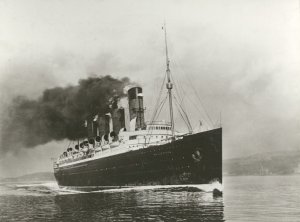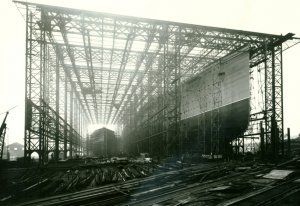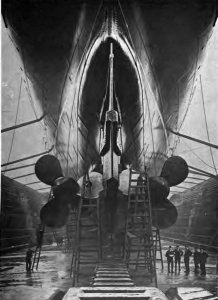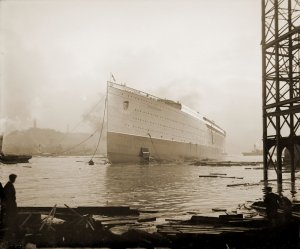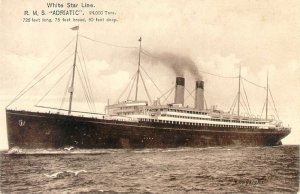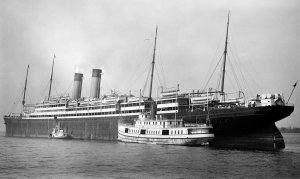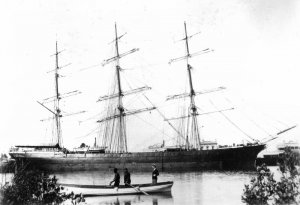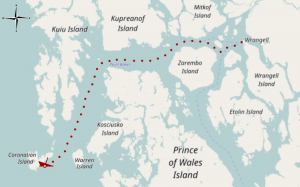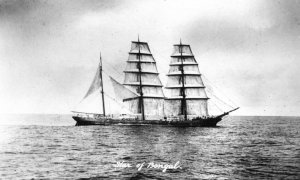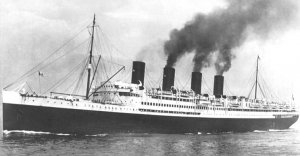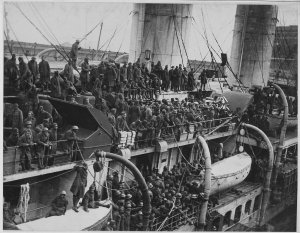Today in Naval History - Naval / Maritime Events in History
19 September 1785 - Launch of French Fougueux, 74 gun Téméraire class Ship of the Line at Lorient
Fougueux was a Téméraire class 74-gun French ship of the line built at Lorient from 1784 to 1785 by engineer Segondat.
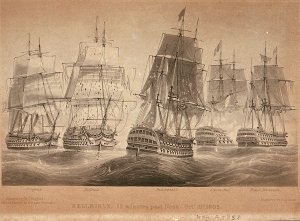
Belleisle 15 minutes past Noon. Octr 21st 1805. Fougueux. Belleisle. Indomptable. Santa Ana. Royal Sovereign (PAD5707)
Read more at http://collections.rmg.co.uk/collections/objects/109858.html#EeiAeDTRD0VxEGo6.99
Ship history
In 1796, she took part in the Expédition d'Irlande under Esprit-Tranquille Maistral.
She took part in the Battle of Trafalgar, firing the first shot of the battle upon HMS Royal Sovereign. She later attempted to come to the aid of the Redoutable by engaging HMS Temeraire. After badly damaging the Fougueux with broadsides, Temeraire's first-lieutenant, Thomas Fortescue Kennedy, led a boarding party onto Fougueux, entering the French ship via her main deck ports and chains. The French tried to defend the decks port by port, but were steadily overwhelmed. Fougueux's captain, Louis Alexis Baudoin, had suffered a fatal wound earlier in the fighting, leaving Commander François Bazin in charge. On learning that nearly all of the officers were dead or wounded and that most of the guns were out of action, Bazin surrendered the ship to Kennedy.
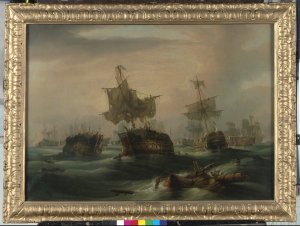
This is a small replica of the painting that Huggins executed for King William IV in 1837, when it was also exhibited at the British Institution. It shows the position of the fleets at 4.30 on the evening of 21 October in a rising gale. Huggins had already done a pair of large paintings of Trafalgar for the King, shown at Exeter Hall in 1834. The prime version of this one, which is chronologically the middle of the three subjects, seems to have been a separate commission. It has now emerged that it is an oil copy, with very slight variations, of a watercolour by Lieutenant Paul Harris Nicolas (1790-1860), who served as a 2nd lieutenant on the 74-gun 'Belleisle' at Trafalgar and was also a younger brother of (Sir) Nicholas Harris Nicolas, later editor of Nelson's dispatches. Inscriptions along the lower edge of the watercolour's frame identify the ships shown: to the left in stern view in the distance the French 'Redoutable', 74, lashed alongside the British 'Temeraire', 98, with the 'Fougueux' 74, on the latter's right but hidden by the dismasted hulk of the 'Santa Ana', 112, taken by the 'Royal Sovereign', Collingwood's 100-gun flagship. This is the principal subject in port-bow view, centre left, with only her foremast standing. To her right are Rear-Admiral Dumanoir and four French ships escaping southward, with 'Victory' in distant starboard-quarter view. An unnamed captured French ship is next, in stern view slightly to port with only mainmast standing, then the bow of the 'Santisima Trinidad', 130, in starboard view with the stern (in port-quarter view) of the 'Nepture' 98 beyond and the 'Leviathan', 74, at the far right edge of the composition. Nicolas is known to have done at least one other watercolour of the battle, showing the situation of the 'Belleisle' at 1.00 p.m. but the dates of execution are not known. He became full lieutenant in July 1808, served at Basque Roads in 1810 and went onto half-pay in September 1814. He lived to receive the Naval General Sevice medal and also wrote a history of the Royal Marines.
Read more at http://collections.rmg.co.uk/collections/objects/12034.html#eFF9cFB7BDOjkuPD.99
According to the report of Captain Lucas of the Redoutable,
“the Fougueux, which, having fought against several of the enemy's ships, had been left by them without having lowered her flag. She was dismasted and unrigged, and floating an unmanageable hulk. On fouling the group of ships she was boarded by the Temeraire. The Fougueux was, however, beyond making serious resistance. Her brave captain, Baudouin, though, even then made an effort, but in vain. He was killed at the outset, and his second in command was wounded at the same moment; whereupon some men of the Temeraire sprang on board and took possession.”
On the day after the battle a severe storm battered the surviving ships. Fougueux was driven ashore near Torre Bermeja on the coast of Spain and was wrecked. Only 25 men aboard, British prize crew and French prisoners, survived
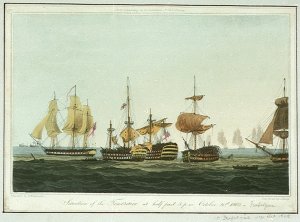
Hand-coloured aquatint and etching inscribed above: "From a painting in the possession of Sir E. Harvey" (Sir Eliot Harvey was captain of the Temeraire), and below: "Situation of the Temeraire at half past 3pm October 21st 1805". The picture shows the Temeraire in action against the Fougueux and the Redoutable during the Battle of Trafalgar. The Redoutable lost her main and mizzen masts; her main falling on the after-part of the Temeraire. Both the Fougueux and the Redoutable were taken, and, by the point in the battle depicted, both ships had ceased any resistance. Earlier in the action, both Fougueux and Redoutable had been lashed to Temeraire (see W. Laird Clowes 'The Royal Navy - a History' Vol. 5, pp.146-7). The ships are shown with Redoutable, her main and mizzen masts down, in the right centre of the picture, while Temeraire is in the centre and Fougueux on her port side in the centre left. The frigate on the left probably represents the Sirius arriving, having received a signal to take Temeraire in tow (see 'Great Sea Fights', Vol. 2, pp. 220, 314; pub. Navy Records Society, 1900).
Read more at http://collections.rmg.co.uk/collections/objects/109879.html#cBpl1WTgloPWq7sp.99
https://en.wikipedia.org/wiki/French_ship_Fougueux_(1785)
https://en.wikipedia.org/wiki/Téméraire-class_ship_of_the_line
19 September 1785 - Launch of French Fougueux, 74 gun Téméraire class Ship of the Line at Lorient
Fougueux was a Téméraire class 74-gun French ship of the line built at Lorient from 1784 to 1785 by engineer Segondat.

Belleisle 15 minutes past Noon. Octr 21st 1805. Fougueux. Belleisle. Indomptable. Santa Ana. Royal Sovereign (PAD5707)
Read more at http://collections.rmg.co.uk/collections/objects/109858.html#EeiAeDTRD0VxEGo6.99
Ship history
In 1796, she took part in the Expédition d'Irlande under Esprit-Tranquille Maistral.
She took part in the Battle of Trafalgar, firing the first shot of the battle upon HMS Royal Sovereign. She later attempted to come to the aid of the Redoutable by engaging HMS Temeraire. After badly damaging the Fougueux with broadsides, Temeraire's first-lieutenant, Thomas Fortescue Kennedy, led a boarding party onto Fougueux, entering the French ship via her main deck ports and chains. The French tried to defend the decks port by port, but were steadily overwhelmed. Fougueux's captain, Louis Alexis Baudoin, had suffered a fatal wound earlier in the fighting, leaving Commander François Bazin in charge. On learning that nearly all of the officers were dead or wounded and that most of the guns were out of action, Bazin surrendered the ship to Kennedy.

This is a small replica of the painting that Huggins executed for King William IV in 1837, when it was also exhibited at the British Institution. It shows the position of the fleets at 4.30 on the evening of 21 October in a rising gale. Huggins had already done a pair of large paintings of Trafalgar for the King, shown at Exeter Hall in 1834. The prime version of this one, which is chronologically the middle of the three subjects, seems to have been a separate commission. It has now emerged that it is an oil copy, with very slight variations, of a watercolour by Lieutenant Paul Harris Nicolas (1790-1860), who served as a 2nd lieutenant on the 74-gun 'Belleisle' at Trafalgar and was also a younger brother of (Sir) Nicholas Harris Nicolas, later editor of Nelson's dispatches. Inscriptions along the lower edge of the watercolour's frame identify the ships shown: to the left in stern view in the distance the French 'Redoutable', 74, lashed alongside the British 'Temeraire', 98, with the 'Fougueux' 74, on the latter's right but hidden by the dismasted hulk of the 'Santa Ana', 112, taken by the 'Royal Sovereign', Collingwood's 100-gun flagship. This is the principal subject in port-bow view, centre left, with only her foremast standing. To her right are Rear-Admiral Dumanoir and four French ships escaping southward, with 'Victory' in distant starboard-quarter view. An unnamed captured French ship is next, in stern view slightly to port with only mainmast standing, then the bow of the 'Santisima Trinidad', 130, in starboard view with the stern (in port-quarter view) of the 'Nepture' 98 beyond and the 'Leviathan', 74, at the far right edge of the composition. Nicolas is known to have done at least one other watercolour of the battle, showing the situation of the 'Belleisle' at 1.00 p.m. but the dates of execution are not known. He became full lieutenant in July 1808, served at Basque Roads in 1810 and went onto half-pay in September 1814. He lived to receive the Naval General Sevice medal and also wrote a history of the Royal Marines.
Read more at http://collections.rmg.co.uk/collections/objects/12034.html#eFF9cFB7BDOjkuPD.99
According to the report of Captain Lucas of the Redoutable,
“the Fougueux, which, having fought against several of the enemy's ships, had been left by them without having lowered her flag. She was dismasted and unrigged, and floating an unmanageable hulk. On fouling the group of ships she was boarded by the Temeraire. The Fougueux was, however, beyond making serious resistance. Her brave captain, Baudouin, though, even then made an effort, but in vain. He was killed at the outset, and his second in command was wounded at the same moment; whereupon some men of the Temeraire sprang on board and took possession.”
On the day after the battle a severe storm battered the surviving ships. Fougueux was driven ashore near Torre Bermeja on the coast of Spain and was wrecked. Only 25 men aboard, British prize crew and French prisoners, survived

Hand-coloured aquatint and etching inscribed above: "From a painting in the possession of Sir E. Harvey" (Sir Eliot Harvey was captain of the Temeraire), and below: "Situation of the Temeraire at half past 3pm October 21st 1805". The picture shows the Temeraire in action against the Fougueux and the Redoutable during the Battle of Trafalgar. The Redoutable lost her main and mizzen masts; her main falling on the after-part of the Temeraire. Both the Fougueux and the Redoutable were taken, and, by the point in the battle depicted, both ships had ceased any resistance. Earlier in the action, both Fougueux and Redoutable had been lashed to Temeraire (see W. Laird Clowes 'The Royal Navy - a History' Vol. 5, pp.146-7). The ships are shown with Redoutable, her main and mizzen masts down, in the right centre of the picture, while Temeraire is in the centre and Fougueux on her port side in the centre left. The frigate on the left probably represents the Sirius arriving, having received a signal to take Temeraire in tow (see 'Great Sea Fights', Vol. 2, pp. 220, 314; pub. Navy Records Society, 1900).
Read more at http://collections.rmg.co.uk/collections/objects/109879.html#cBpl1WTgloPWq7sp.99
https://en.wikipedia.org/wiki/French_ship_Fougueux_(1785)
https://en.wikipedia.org/wiki/Téméraire-class_ship_of_the_line








 haven
haven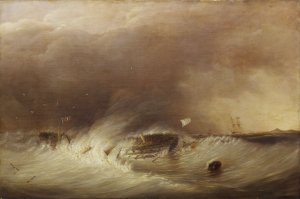
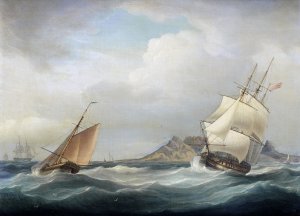
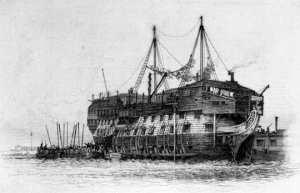
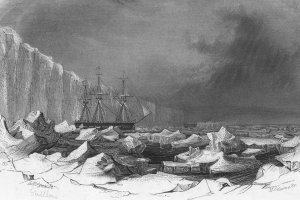
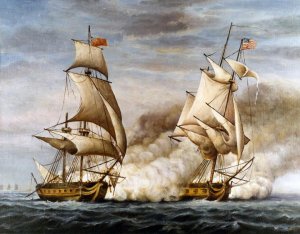

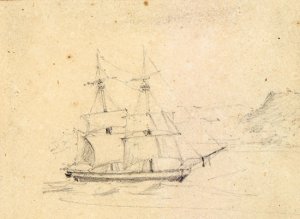
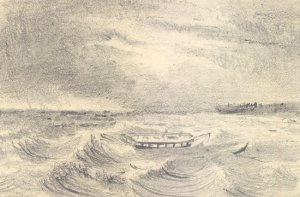


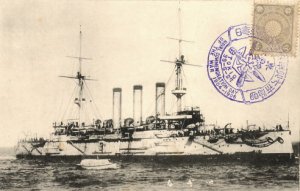
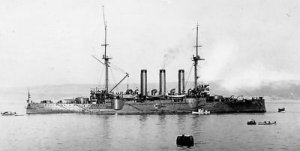
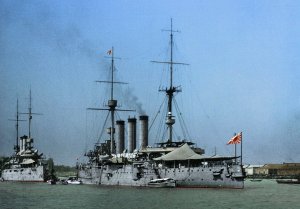
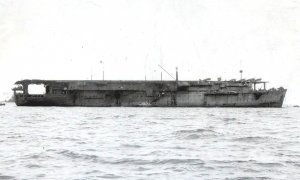
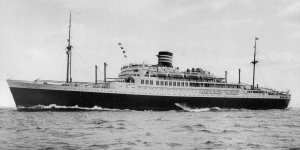
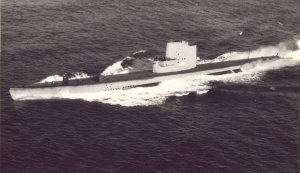

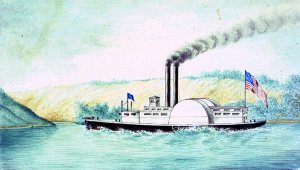
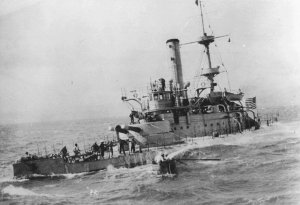
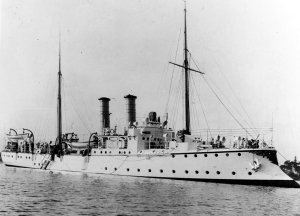
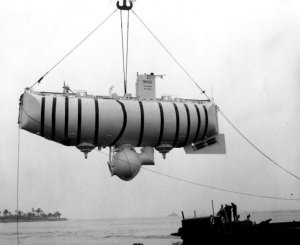
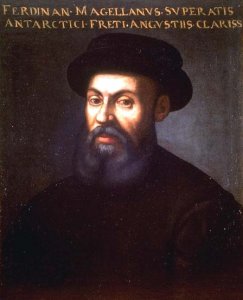
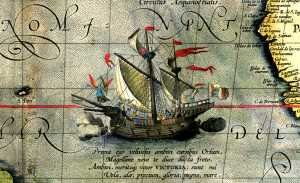
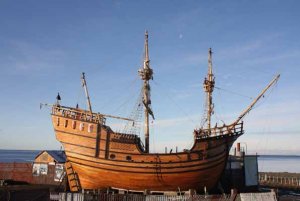

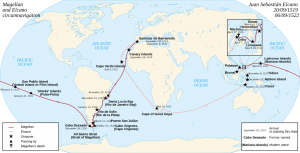
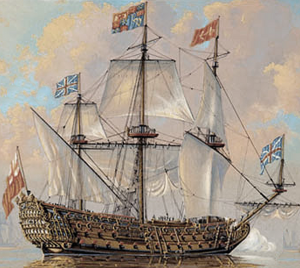
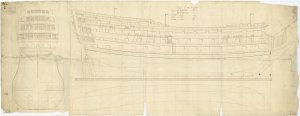
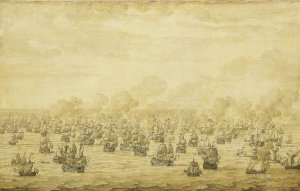
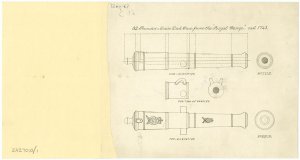
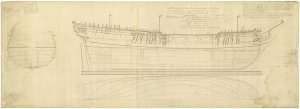
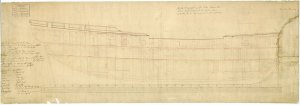
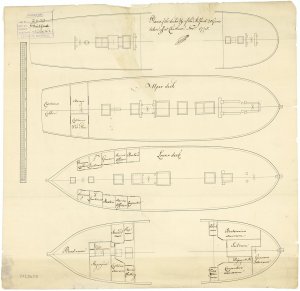


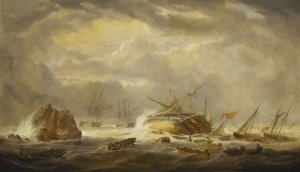
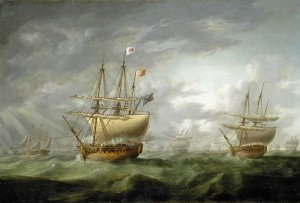

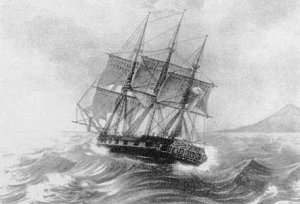
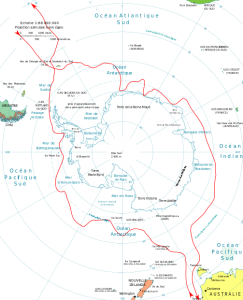
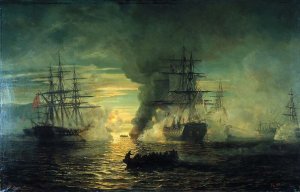
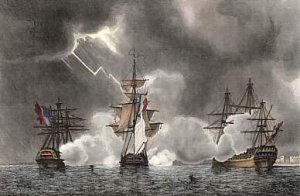
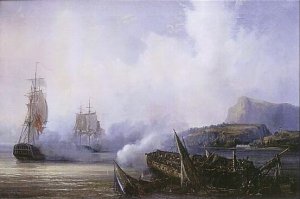
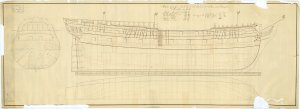
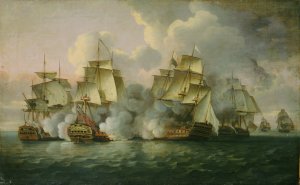

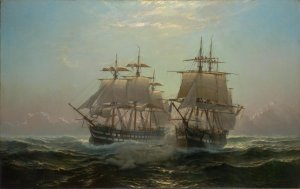

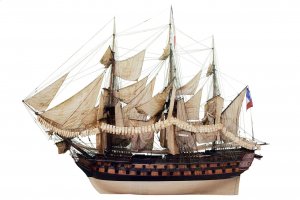
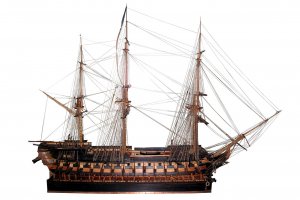
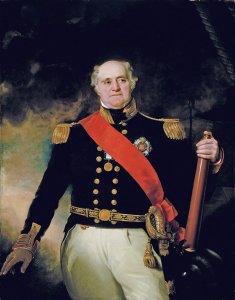



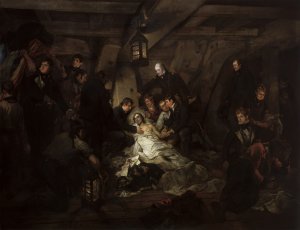

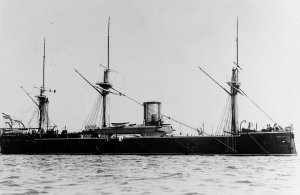
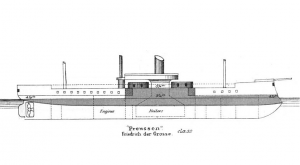
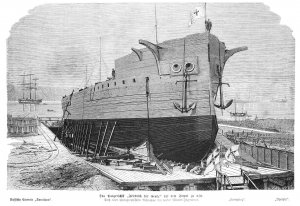
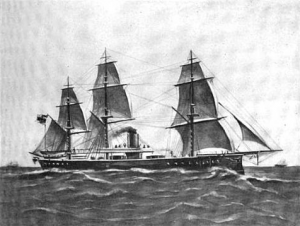
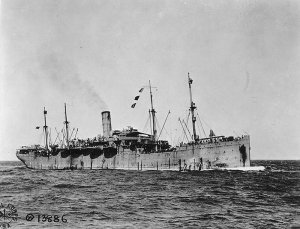



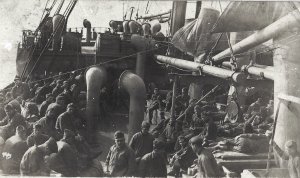




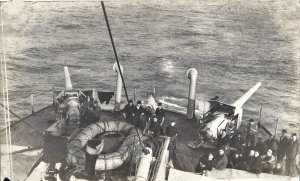

 , Virginia
, Virginia